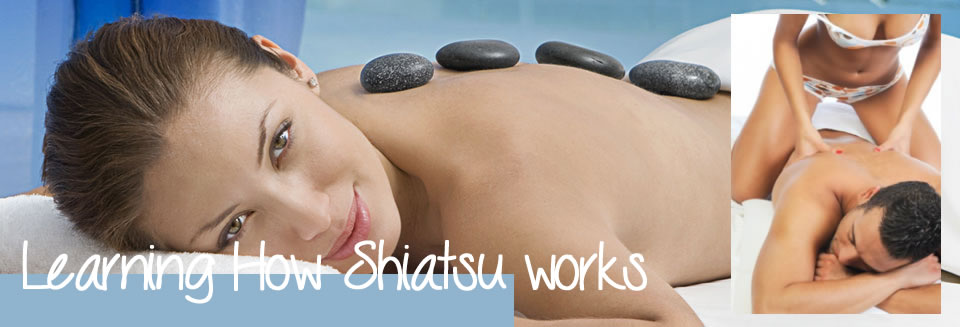Learn Shiatsu
Learning How Shiatsu can work for you
Bring in the new year - Learn Shiatsu's Introduction to shiatsu contains very important pointers that will help you learn the art of Shiatsu effectively; it also presents some important 'do's and don'ts' to consider when giving a Shiatsu treatment.
See commonly asked questions about Yoga
Therefore it is strongly recommended that you read it carefully before proceeding to Part One.
- Yin and Yang
- THE ABDOMEN TREATMENT
- Leg Pressure Points
- Preparing for a Shiatsu Session
- The Five Elements
- Shoulder pressure points
- THE STEP-BY-STEP SEQUENCE
- RESOURCES
- The origins of Shiatsu
- Techniques
- How to find the points
- POINTS TO REMEMBER
- How much pressure to use
- SELF-SHIATSU
- Choosing a school or practitioner
- SELF-TREATMENT
- Shoulders Treatment
- Vital organs
- Energy channels
- TREATING THE INDIVIDUAL
- DEVELOPING YOUR TECHNIQUE
- Energy in the hands
- Hara and breathing
- SELF-DEVELOPMENT EXERCISES
- Back of body treatment
- Front of leg pressure points
- Toe Treatment
- Tsubos
- Kyo and Jitsu
- Increasing your sensitivity
- Governing Vessel
- Forehead Massage

Other sites to look at
| capital-spas.co.uk |
| katyperrybeauty.co.uk |
Shiatsu Techniques
There is no standard procedure, or hard-and-fast routine, for a full Shiatsu treatment; rather, each practitioner and teacher has a somewhat individualized repertoire of techniques from which he or she will draw according to the requirements of each individual case. The sequence presented in Part One is a basic but comprehensive one, which incorporates commonly used elements of Shiatsu treatment. If you study Shiatsu further, this sequence will serve as a framework for other components and can be varied to suit particular circumstances. You will also naturally develop your own style as you gain experience.
Shiatsu uses pressure to affect the internal body energy or Ki, as described already, but the means used can be very diverse. The various methods include pressing, stretching, kneading, rubbing, shaking, pounding and rocking. Furthermore, there are a number of different ways that pressure can be brought to bear - with the thumbs, palms, fingers, elbows or feet. The methods in this book concentrate on thumb and palm pressure, but finger and foot pressure are also touched upon.
The most frequently used combination of these methods and tools, and the ones to become familiar with first, are:
• overall stretches
• pressure with the palms
• pressure-point work with the thumbs.
Use the upper part of the pad, rather than the actual tip. Always keep the thumb straight as you apply pressure; some people find the thumb joint is rather weak at first, but this should improve with practice.
When applying palm or thumb pressure, you will mainly be working with a method that uses the two hands in different ways - the 'working' hand leans in, moving along the required path, while the 'support' hand remains passively in one place applying moderate pressure.
All these techniques will be explained fully with step-by-step photography and detailed captions as you work your way through the treatment sequence in Part One.
Shiatsu Techniques
There is no standard procedure, or hard-and-fast routine, for a full Shiatsu treatment; rather, each practitioner and teacher has a somewhat individualized repertoire of techniques from which he or she will draw according to the requirements of each individual case. The sequence presented in Part One is a basic but comprehensive one, which incorporates commonly used elements of Shiatsu treatment. If you study Shiatsu further, this sequence will serve as a framework for other components and can be varied to suit particular circumstances. You will also naturally develop your own style as you gain experience.
Shiatsu uses pressure to affect the internal body energy or Ki, as described already, but the means used can be very diverse. The various methods include pressing, stretching, kneading, rubbing, shaking, pounding and rocking. Furthermore, there are a number of different ways that pressure can be brought to bear - with the thumbs, palms, fingers, elbows or feet. The methods in this book concentrate on thumb and palm pressure, but finger and foot pressure are also touched upon.
The most frequently used combination of these methods and tools, and the ones to become familiar with first, are:
• overall stretches
• pressure with the palms
• pressure-point work with the thumbs.
Use the upper part of the pad, rather than the actual tip. Always keep the thumb straight as you apply pressure; some people find the thumb joint is rather weak at first, but this should improve with practice.
When applying palm or thumb pressure, you will mainly be working with a method that uses the two hands in different ways - the 'working' hand leans in, moving along the required path, while the 'support' hand remains passively in one place applying moderate pressure.
All these techniques will be explained fully with step-by-step photography and detailed captions as you work your way through the treatment sequence in Part One.
Prices and Tuition
£50 for "First Session" Pilates or Pilates/Yoga or Yoga session, 1 1/2 -2 hours (where a consultation is involved). The first Pilates only or mixed Pilates/Yoga session is £50 for 1 1/2 - 2 hours. £30 for 1 hour £45 for 1 1/2 hours (Minimum rate is £45 for 1 1/2 - 2 hours unless it's a regular £30 1 hour session. ) £60 for 2 hours Other options are available, contact us if for other options. One-to-one rate/small group rates (2-4 clients, rate is the total payment, irrespective of number of participants.) Price reductions are negotiable for regular sessions.
